|
|
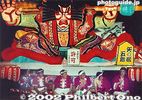
Nebuta Festival ねぶた祭Aomori
|
|
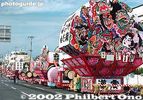
There are three types of floats: the large fan-shaped Neputa, Nebuta-type figures, and the children's small Neputa.I got to Hirosaki early enough before the parade to see the floats lined up at the starting point. Hirosaki is a 30-min. train ride from Aomori, and best known for Hirosaki Castle during cherry blossom season.
|
|

According to one story, the Nebuta has its roots in the 8th century.According to one story, the Nebuta has its roots in the 8th century when there was a rebellion in Ezo (Hokkaido). Ordered by Emperor Kanmu to quell the rebellion, generalissmo Sakanoue no Tamuramaro went to Ezo. However, he failed to capture the elusive chief of Ezo who went into hiding in the mountains.
Sakanoue then set up a trap with large votive lanterns which were lit and accompanied by taiko drums and flutes. This lured the curious Ezo chief out of hiding and led to his capture. The large lanterns were the forerunner of the Nebuta.
|
|
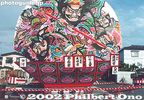
Fan-shaped Neputa float.The painted picture on the front of the Neputa depicts mostly warriors and on the back are beautiful courtesans.
|
|

The floats were jerked left and right and spun around.At 7:00 p.m., the taiko drum-beating started and the floats left the starting point one by one. The beat of the taiko drums was the same as that in the Nebuta Matsuri. A few men stood on the top of the large Neputa and collapsed the hinged, top portion to clear overhead power lines. The floats were jerked left and right and spun around.
|
|

Balancing act. The kanto symbolize rice plants ready to be harvested.This is perhaps the most anxiety-provoking festival. Men in happi coats balance these tall paper lantern-bedecked bamboo poles, called kanto, on their foreheads, shoulders, hand palms, or hips. While watching, you can't help thinking, "Will it fall?" or worse, "Will it fall on me?" The candle-lit paper lanterns contrasted nicely against the dark sky.
|
|
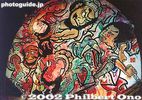
Closeup of a Neputa float.Theories concerning the origin of the Neputa are identical to those of the Nebuta. However, in the 1880's, the Neputa gradually changed from human figures into a fan shape. The floats have come a long way since then. Candles have been replaced by generator-powered lights and the washi paper has been replaced by washi paper blended with nylon. The festival is designated as an Important Intangible Folk Culture Asset.
|
|

The kanto's paper lanterns and the performers' happi coats are emblazoned with the crest of the respective city block.Thirty-seven city blocks were represented. There were also corporate logos on some lanterns.
|
|

Taking it to the limits.This guy is balancing a super-high kanto while the pole arches to an extreme degree. During the final moments, he ran across the road to maintain the balance long enough for the pole to snap under the weight of the lanterns. That was really neat. In the right photo, a crashed kanto is readied for another balancing attempt.
|
|

Hino Hifuri Festival, Shiga.
|
|

Tokushima Awa Odori dancer
|
|

Tokushima Awa Odori is also called the "Fool's Dance"
|
|
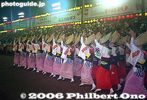
Tokushima Awa Odori
|
|

Koenji Awa Odori, Aoi Shin-ren 葵新連
|
|

Koenji Awa Odori, Aoi Shin-ren 葵新連
|
|
|

Fukagawa Hachiman Matsuri, mizu-kake
|
|

The mikoshi is raised high as they all bathe in water. Taking photos like this one requires adequate water protection of your camera and lens.
|
|
|

Onegaishimasu! お願いします!
|
|

Hai, OK (ha-ha!).
|
|

Asagaya Tanabata Matsuri
|
|

Asagaya Tanabata Matsuri, Tokyo
|
|

Some 900,000 of humanity gathered here for the Edogawa-ku Fireworks in Aug.
|
|

Michael Jackson tribute in Aug. 2009, Fussa Tanabata Matsuri, Tokyo. Very good likeness.
|
|

On the reverse side of MJ, was Barack Obama, Fussa Tanabata Matsuri, Tokyo
|
|
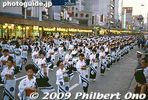
In the evening on the second day of Hachioji Matsuri is a large folk dance parade called Minyo Nagashi during 4 pm to 6 pm. 民踊流し
|
|

This float had a group of tekomai women, Hachioji Matsuri.
|
|

She was doing it to music. Hachioji Matsuri.
|
|
|
|

Women in yukata watching the Hachioji Matsuri.
|
|

Pulling a float at Hachioji Matsuri.
|
|

Shishimai lion dance, Hachioji Matsuri.
|
|

Very crowded at Hachioji Matsuri.
|
|

For many women, hula is good exercise, recreational fun, or a chance to look and feel like a different person. The colorful costumes, flowers, attractive movements, and glamorous setting are all very appealing.
|
|

The audience sit on the Stone Steps to watch the "Street corner hula." So what did they do when it rained?
|
|

Goraku-ren 伍楽連
|
|

Koenji Awa Odori
|
|

Koenji Awa Odori, Daisan Kikaku-ren 第三企画連
|
|

For the 12th Ikaho Hawaiian Festival held during Aug. 3-6, 2008, Hula Halau'O Kamuela performed every night for an hour as the festival's main event (free admission). 伊香保ハワイアンフェスティバルのメリーモナークショー
|
|

Near Kinomoto Station is Jizo-zaka road, a slightly sloping cobblestone road leading to the Jizo-in temple. During the annual Kinomoto Jizo Ennichi Festival held on Aug. 22-25, this road is packed with food stalls and people going to worship. 地蔵縁日
|
|

You can exchange the balls with prizes (more balls = better prizes).
|
|

MInami-Koshigaya Awa Odori Dance, indoor performance. 南越谷阿波踊り
|
|
|
|

This joint session of Minami-Koshigaya Awa Odori dance troupes was the best performance of all, I thought.
|
|

Minami-Koshigaya Awa Odori, Saitama Prefecture.
|
|

Rhythm-ren gave a great performance too, Mitaka Awa Odori.
|
|

Rhythm-ren, Mitaka Awa Odori
|
|

Mitaka Awa Odori 道志連
|
|

Budo-ren, Mitaka Awa Odori 富道連
|
|

Otsuka Awa Odori, Tokyo
|
|
|
|

Yuka-chan, A.B.S.UNIDOS DO URBANA based in Nagoya at Asakusa Samba 2016.
|
|

Asakusa Samba Carnival
|
|

Asakusa Samba Carnival
|
|
|
|

Asakusa Samba Carnival
|
|

Asakusa Samba Carnival
|
|

Asakusa Samba 2016 onsen-theme float
|
|
|
|
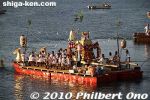
The main mikoshi on the boat during the Senko-sai festival on Setagawa River in Otsu.
|
|

Boat with the main portable shrine pass under Seta-no-Karahashi Bridge.
|
|
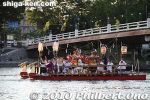
Boat with the three portable shrines pass under Seta-no-Karahashi Bridge.
|
|

On the morning of Aug. 6, the first day of Sendai Tanabata, shop owners started to set up their tanabata bamboo decorations from around 8 am to 9 am.
|
|

This was my second time to see Sendai Tanabata. The first time was quite some time ago. I had high expectations, and I was not disappointed.
|
|

The take-kazari bamboo decorations were marvelous. A myriad of designs and variety. Paper was the main material used to make all these decorations, unlike the predominant plastic found at other Tamabata Festivals in Japan.
|
|

Many girls (and kids) dressed in yukata (cotton kimono) came to see the Tanabata Festival. Her facial reaction was typical.
|
|

Tiny origami paper cranes. Guess how many paper cranes there are? Over 1 million.
|
|

A short walk from Jozenji-dori is the Shimin Hiroba (Citizens' Square) where there was a stage for more entertaining performances by numerous groups. The program started at 6 pm and ended at 8:45 pm.
|
|
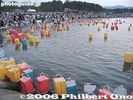
At 6:30 pm, people started releasing their candlelit lanterns into the ocean. Tsuruga, Fukui Pref.
|
|

Toro nagashi at Kehi no Matsubara Beach in Tsuruga, Fukui Pref.
|
|
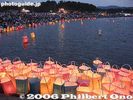
As it got darker, the scene got prettier.
|
|

Toro nagashi and fireworks at Tsuruga, Fukui Pref.
|
|

The light of the fireworks immediately attracted a swarm of bugs which died from the fire and dropped into the river. Stupid bugs.
|
|

Held since 1963, the Yamagata Hanagasa Matsuri festival is held annually during Aug. 5-7. It is an evening parade of dancers using a hanagasa (flower hat) held during the three evenings from 6 pm to 9:30 pm.
|
|
|
|

Yamagata Hanagasa Matsuri
|
|
|
|
|
|